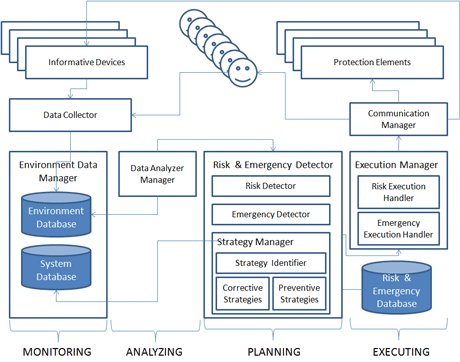by MariaGrazia Fugini and Claudia Raibulet
A significant number of accidents still occur in the work-place. We describe the WIRI project which investigates how such accidents can be prevented by the employment of user-friendly IT technologies aimed at identifying risky situations.
Many accidents in the work-place are the result of risky situations which could well have been identified by the employment of appropriate IT technologies. The main objective of WIRI (Wearable Instruments for Risk Intervention) is to apply IT technology such as sensors, service-oriented software, web technologies and hardware-software co-design methods in the work-place, in order to detect risks and address them before they become emergencies. We have studied both the social and technological aspects of this challenge, focusing on if and how wearable garments and services can be employed in working environments. In order to do this, we have tried to understand the nature of a risk or a risky situation to enable us to model and simulate such situations. In particular, we have investigated whether Web-based technologies can be used and have identified which of the available architectural styles and patterns are most suitable, Finally, we have experimented with a prototype self-healing system capable of diagnosing and analysing risks, and of executing self-managed intervention strategies for preventing or dealing with them.

Figure 1: The Architecture of Our Risk Management System.
When designing solutions for risk identification and management in the work-place, we have encountered a number of challenges. These challenges have to be studied before we can address more complex issues such as prevention, analysis of the impact of combined risks, or investigation of the effectiveness of the strategies currently adopted.
These issues are summarized as follows:
- How can risks and risk prevention strategies be defined and how should risks be addressed at run time?
- How can the level of danger of a risk and the likelihood that it will lead to an emergency be identified dynamically?
- How can complex risks, which are generated when two or more simple risks occur simultaneously, be identified?
- What architecture is most suitable as a solution for risk management in working environments?
Our approach to risk management uses the Monitoring, Analysing, Planning, Executing (MAPE) loop typical of control systems and currently used in the engineering of self-adaptive and self-managing systems (see the Figure 1). This loop observes the environment, detects anomalies by analysing the data collected during the monitoring stage, identifies risky situations and decides on necessary changes, and executes planned modifications in the work environment. This solution can be exploited to address both risky situations through preventive strategies, as well as emergencies through corrective strategies.
One research problem is the standardization of the data collected from different sensors and ambient devices. We believe that a service-oriented approach should be adopted, acquiring all the data in a uniform format, eg XML, in order to facilitate device and system interoperability.
A second research question relates to testing the practicability of a (web) service approach to risk management. So far we have no practical results showing the performance required for such applications from (web) services, thus we are developing a prototype that can simulate risky situations starting from a risk map of the workplace, showing the people and machines in movement. Such situations can be monitored for a given period of time in order to analyse the causes of risky situations and to generate reports showing system compliance with safety regulations and norms. We are also now working on producing a prototype that can be used in seminars and courses on risk prevention.
The project begun by the Politecnico di Milano in collaboration with the University of Milano-Bicocca at the beginning of 2009. It is partly funded by the EC 7th Framework Program under the Network of Excellence S-Cube – Grant Agreement no. 215483 and by the Italian TEKNE Project. Luigi Ubezio and Filippo Ramoni have actively contributed to the system design and prototyping. A number of SMEs in Lombardy, including the Carlo Gavazzi S.p.A. have supplied valuable input in the form of both software and sensors, and have provided feedback on the usage of smart textiles in risky environments. This research is also conducted with the INDACO Dept. of Design and the Dept. of Management Engineering of Politecnico di Milano with respect to the usability of wearable services and to norms and regulations concerning safety in the work-place.
Please contact:
MariaGrazia Fugini, Polytecnico di Milano, Italy
E-mail:
Claudia Raibulet
University of Milano-Bicocca, Italy
E-mail:










